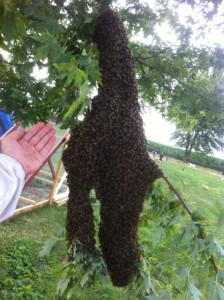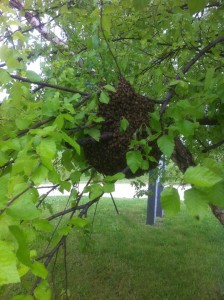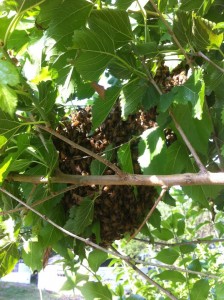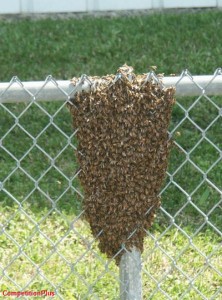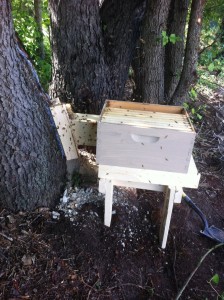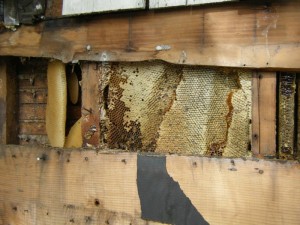REPORTING A SWARM OF HONEY BEES
Have thousands of honey bees just invaded your property or adjacent area and have now settled in a large clump on a tree, a fence or on some other object? The mass of bees, called a swarm, may be as small as a softball or larger than a basketball. You may feel terrified and think that your family is in great danger and you want them removed as soon as possible. The following questions and answers may help you understand the nature of swarming, how to remove the problem, and help a beekeeper save the honey bees.
Honey bees are extremely important, not only for honey production but also for the beneficial pollination they provide. We can thank the honey bee for helping to provide one-third of the food we consume. The honey bee population has declined dramatically recently due to a number of diseases, parasites, and other factors.
Is the swarm dangerous?
No. Honey bees in a swarm are unlikely to be aggressive and sting anyone unless you attack the bees. At this stage, they do not have a home to defend, and they have filled up with honey in preparation for the flight to a new permanent home. If the honey bees stay and construct a wax nest, they will become aggressive if you disturb them.
Where did the honey bees in my yard come from?
There is a good possibility that a permanent nest (feral hive) of bees is located close to the swarm that has just landed. This could be in the cavity of a tree, building, abandoned barrel, etc. This nest (colony) had a large population of honey bees that ran out of room to store honey, pollen, and raise new bees. When this occurs, the bees will begin to raise new queens. Shortly before the new queens hatch, the old queen will leave the hive with about half of the bees. The queen and bees will usually fly only a short distance (swarm). The queen will land on some object and the bees will cluster around her forming the swarm. If the first swarm does not reduce the crowding enough, a second swarm may emerge.
What will the swarm of honey bees do next if I don’t do anything?
Scout bees from the swarm will fly out to try to find a permanent home. If they find a suitable cavity, they return to the swarm and perform a dance within the cluster communicating the location, size, and other information about the possible new home. Bees receiving this information will fly to this location to investigate. When a sizable number of bees do the dance for a given location, the entire swarm will leave and fly to the new nest site.
How long does it take bees to find a new home?
It could take just a few hours, several days, or it may not occur at all. If the scout bees do not find a suitable site, they may begin building an exposed nest at the swarm location (in a tree, on the side of your house, etc.) This nest may become a problem to you. If you want a beekeeper to capture the swarm, it is important to contact him or her as soon as possible.
How do I locate a beekeeper?
Submit a swarm report using the form below. Add as much information as possible including an address, contact phone number, when the swarm arrived or was first noticed, what they are clustered on (tree, bush, wall, etc), and how high off the ground. All this information is important for the beekeeper to determine what equipment she/he needs to bring to remove your swarm.
What about an established colony in a wall or tree?
Bees in a structure or tree can be removed successfully without destroying the colony in most cases. This takes more skill and experience, but we do have members that can remove bees from a structure as well. Contact us for assistance and we’ll put you in touch with someone that can help you out.
Locations where members have removed honey bee swarms in the Peoria area.
View HIBA Honeybee swarm captures and bee removals on a larger map.
If you live outside of Central Illinois please find a more suitable club for the removal on the map at the bottom of this page.

